Experimental Verification of the Shielding Properties of Selected Textile Materials in the X Frequency Band
Abstract
:1. Introduction
2. Theoretical Background of the Experiment
3. Materials and Methods
3.1. Samples under Investigation
3.2. EMI Shielding Measurements
4. Results and Discussion
4.1. Sample Conductivity
4.2. Validation of the Shielding Effectiveness Measurements
4.3. The SE of Textile and 3D-Printed Fabrics
- The fabric samples were mounted on the fixture within the test setup.
- The elements of the STA matrix were measured.
- The elements of the STS scattering matrix were determined by using the aforementioned Formulas (13) and (14).
- The results were corrected based on the measurements of the theoretical SE for aluminum foil according to the formula
- 5.
- The SE is evaluated by means of the Formulas (6)–(8).
5. Conclusions and Outlook
Author Contributions
Funding
Institutional Review Board Statement
Informed Consent Statement
Data Availability Statement
Conflicts of Interest
References
- Wang, H.; Li, S.N.; Liu, M.Y.; Zhou, Y. Review on Shielding Mechanism and Structural Design of Electromagnetic Interference Shielding Composites. Macromol. Mater. Eng. 2021, 306, 2100032. [Google Scholar] [CrossRef]
- Peng, M.Y.; Qin, F.X. Clarification of basic concepts for electromagnetic interference shielding effectiveness. J. Appl. Phys. 2021, 130, 225108. [Google Scholar] [CrossRef]
- Duan, Y.P.; Liu, S.H.; Guan, H.T. Investigation of electrical conductivity and electromagnetic shielding effectiveness of polyaniline composite. Sci. Technol. Adv. Mater. 2005, 6, 513–518. [Google Scholar]
- Guan, H.T.; Chung, D.D.L. Absorption-dominant radio-wave attenuation loss of metals and graphite. J. Mater. Sci. 2021, 56, 8037–8047. [Google Scholar] [CrossRef]
- Dai, M.W.; Zhai, Y.H.; Zhang, Y. A green approach to preparing hydrophobic, electrically conductive textiles based on waterborne polyurethane for electromagnetic interference shielding with low reflectivity. Chem. Eng. J. 2021, 421, 127749. [Google Scholar] [CrossRef]
- Wu, J.H.; Chung, D.D.L. Increasing the electromagnetic interference shielding effectiveness of carbon fiber polymer–matrix composite by using activated carbon fibers. Carbon 2002, 40, 445–467. [Google Scholar] [CrossRef]
- Roh, J.-S.; Chi, Y.-S.; Kang, T.J. Electromagnetic shielding effectiveness of multifunctional metal composite fabrics. Text. Res. J. 2008, 78, 825–835. [Google Scholar] [CrossRef]
- Mocha, J.; Wójcik, D.; Surma, M. Immunity of medical electrical equipment to radiated RF disturbances. Proc. SPIE 2018, 10715, 1071507. [Google Scholar]
- Ren, S.; Guo, S.; Liu, X.; Liu, Q. Shielding effectiveness of double-layer magnetic shield of current comparator under radial disturbing magnetic field. IEEE Trans. Magn. 2016, 52, 9401907. [Google Scholar] [CrossRef]
- Wang, Y.; Wang, W.; Qi, Q.B.; Xu, N.; Yu, D. Layer-by-layer assembly of PDMS-coated nickel ferrite/multiwalled carbon nanotubes/cotton fabrics for robust and durable electromagnetic interference shielding. Cellulose 2020, 27, 2829–2845. [Google Scholar] [CrossRef]
- Ghosh, S.; Remanan, S.; Mondal, S.; Ganguly, S.; Das, P.; Singha, N.; Das, N.C. An approach to prepare mechanically robust full IPN strengthened conductive cotton fabric for high strain tolerant electromagnetic interference shielding. Chem. Eng. J. 2018, 344, 138–154. [Google Scholar] [CrossRef]
- Blachowicz, T.; Hütten, A.; Ehrmann, A. Electromagnetic Interference Shielding with Electrospun Nanofiber Mats—A Review of Production, Physical Properties and Performance. Fibers 2022, 10, 47. [Google Scholar] [CrossRef]
- Blachowicz, T.; Wojcik, D.; Surma, M.; Magnuski, M.; Ehrmann, G.; Ehrmann, A. Textile fabrics as electromagnetic shielding materials—A review of preparation and performance. Fibers 2023, 11, 29. [Google Scholar] [CrossRef]
- Wang, Q.-W.; Zhang, H.-B.; Liu, J.; Zhao, S.; Xie, X.; Liu, L.X.; Yang, R.; Koratkar, N.; Yu, Z.-Z. Multifunctional and Water-Resistant MXene-Decorated Polyester Textiles with Outstanding Electromagnetic Interference Shielding and Joule Heating Performances. Adv. Funct. Mater. 2019, 29, 1806819. [Google Scholar] [CrossRef]
- Uzun, S.; Han, M.K.; Strobel, C.J.; Hantanasirisakul, K.; Goad, A.; Dion, G.; Gogotsi, Y. Highly conductive and scalable Ti3C2Tx-coated fabrics for efficient electromagnetic interference shielding. Carbon 2021, 174, 382–389. [Google Scholar] [CrossRef]
- Yu, Z.C.; Deng, C.; Seidi, F.; Yong, Q.; Lou, Z.C.; Meng, L.C.; Liu, J.W.; Huang, C.; Liu, Y.Q.; Wu, W.B.; et al. Air-permeable and flexible multifunctional cellulose-based textiles for bio-protection, thermal heating conversion, and electromagnetic interference shielding. J. Mater. Chem. A 2022, 10, 17452–17463. [Google Scholar] [CrossRef]
- Periyasamy, A.P.; Yang, K.; Xiong, X.M.; Venkataraman, M.; Militky, J.; Mishra, R.; Kremenakova, D. Effect of silanization on copper coated milife fabric with improved EMI shielding effectiveness. Mater. Chem. Phys. 2020, 239, 122008. [Google Scholar] [CrossRef]
- Hu, S.; Wang, D.; Kyosev, Y.; Kremenakova, D.; Militky, J. The novel approach of EMI shielding simulation for metal coated nonwoven textiles with optimized textile module. Polym. Test. 2022, 114, 107706. [Google Scholar] [CrossRef]
- Hong, S.W.; Yoo, S.S.; Lee, J.Y.; Yoo, P.J. Sonochemically activated synthesis of gradationally complexed Ag/TEMPO-oxidized cellulose for multifunctional textiles with high electrical conductivity, super-hydrophobicity, and efficient EMI shielding. J. Mater. Chem. C 2020, 8, 13990–13998. [Google Scholar] [CrossRef]
- Vahle, D.; Böttjer, R.; Heyden, K.; Ehrmann, A. Conductive polyacrylonitrile/graphite textile coatings. AIMS Mater. Sci. 2018, 5, 551–558. [Google Scholar] [CrossRef]
- Moonlek, B.; Wimolmala, E.; Markpin, T.; Sombatsompop, N.; Saenboonruang, K. Enhancing electromagnetic interference shielding effectiveness for radiation vulcanized natural rubber latex composites containing multiwalled carbon nanotubes and silk textile. Polym. Compos. 2020, 41, 396–4009. [Google Scholar] [CrossRef]
- Zhou, L.H.; Lan, C.T.; Yang, L.; Xu, Z.Z.; Chu, C.L.; Liu, Y.C.; Qiu, Y.P. The optimization of nanocomposite coating with polyaniline coated carbon nanotubes on fabrics for exceptional electromagnetic interference shielding. Diam. Relat. Mater. 2020, 104, 107757. [Google Scholar] [CrossRef]
- Abdelal, N. Electromagnetic interference shielding of stitched carbon fiber composites. J. Ind. Text. 2020, 49, 773–790. [Google Scholar] [CrossRef]
- Pakdel, E.; Kashi, S.; Baum, T.; Usman, K.A.S.; Razal, J.M.; Varley, R.; Wang, X.G. Carbon fibre waste recycling into hybrid nonwovens for electromagnetic interference shielding and sound absorption. J. Clean. Prod. 2021, 315, 128196. [Google Scholar] [CrossRef]
- Hu, Q.L.; Duan, Y.F.; Zheng, X.H.; Nie, W.Q.; Zou, L.H.; Xu, Z.Z. Lightweight, flexible, and highly conductive recycled carbon fiber felt for electromagnetic interference shielding. J. Alloys Comp. 2023, 935, 168152. [Google Scholar] [CrossRef]
- Rybicki, T.; Stempien, Z.; Karbownik, I. EMI Shielding and Absorption of Electroconductive Textiles with PANI and PPy Conductive Polymers and Numerical Model Approach. Energies 2021, 14, 7746. [Google Scholar] [CrossRef]
- Siavashani, V.S.; Gursoy, N.C.; Montazer, M.; Altay, P. Stretchable Electromagnetic Interference Shielding Textile Using Conductive Polymers and Metal Nanoparticles. Fibers Polym. 2022, 23, 2748–2759. [Google Scholar] [CrossRef]
- Yu, Z.C.; Zhao, Y.H.; Liu, J.R.; Wang, Y.S.; Qin, Y.; Zhu, Z.Y.; Wu, C.; Peng, J.C.; He, H.L. Advancement in cellulose-based multifunctional high conductive PNIPAAm/PPy hydrogel/cotton composites for EMI shielding. Cellulose 2022, 29, 6963–6981. [Google Scholar] [CrossRef]
- Schelkunoff, S.A. Electromagnetic Waves; Van Nostrand Company: New York, NY, USA, 1945. [Google Scholar]
- Pozar, D.M. Microwave Engineering, 3rd ed.; John Wiley & Sons: Hoboken, NJ, USA, 2005. [Google Scholar]
- Pocai, M.; Dotto, I.; Festa, D. Three methods for measuring the Shielding Effectiveness of shielding materials: A comparison. In Proceedings of the 2012 IEEE International Symposium on Electromagnetic Compatibility, Pittsburgh, PA, USA, 6–10 August 2012; pp. 663–668. [Google Scholar]
- Costa, F.; Borgese, M.; Degiorgi, M.; Monorchio, A. Electromagnetic Characterisation of Materials by Using Transmission/Reflection (T/R) Devices. Electronics 2017, 6, 95. [Google Scholar] [CrossRef]
- Lin, H.N.; Chen, Y.Y.; Tsai, H.Y.; Lin, M.S. Characteristic Analysis and Applications of Electromagnetic Shielding Materials for Wireless Communications Device. Open Mater. Sci. J. 2016, 10, 44–53. [Google Scholar] [CrossRef]
- Morari, C.; Balan, I. Methods for determining shielding effectiveness of materials: EEA. Electroteh. Electron. Autom. 2015, 63, 126–136. [Google Scholar]
- Zheng, X.H.; Wang, P.; Zhang, X.S.; Hu, Q.L.; Wang, Z.Q.; Nie, W.Q.; Zou, L.H.; Li, C.L.; Han, X. Breathable, durable and bark-shaped MXene/textiles for high-performance wearable pressure sensors, EMI shielding and heat physiotherapy. Compos. A Appl. Sci. Manuf. 2022, 152, 106700. [Google Scholar] [CrossRef]
- Hu, S.; Wang, D.; Periyasamy, A.P.; Kremenakova, D.; Militky, J.; Tunak, M. Ultrathin Multilayer Textile Structure with Enhanced EMI Shielding and Air-Permeable Properties. Polymers 2021, 13, 4176. [Google Scholar] [CrossRef] [PubMed]
- Moazzenchi, B.; Montazer, M. Click electroless plating of nickel nanoparticles on polyester fabric: Electrical conductivity, magnetic and EMI shielding properties. Colloids Surf. A Physicochem. Eng. Asp. 2019, 571, 110–124. [Google Scholar] [CrossRef]
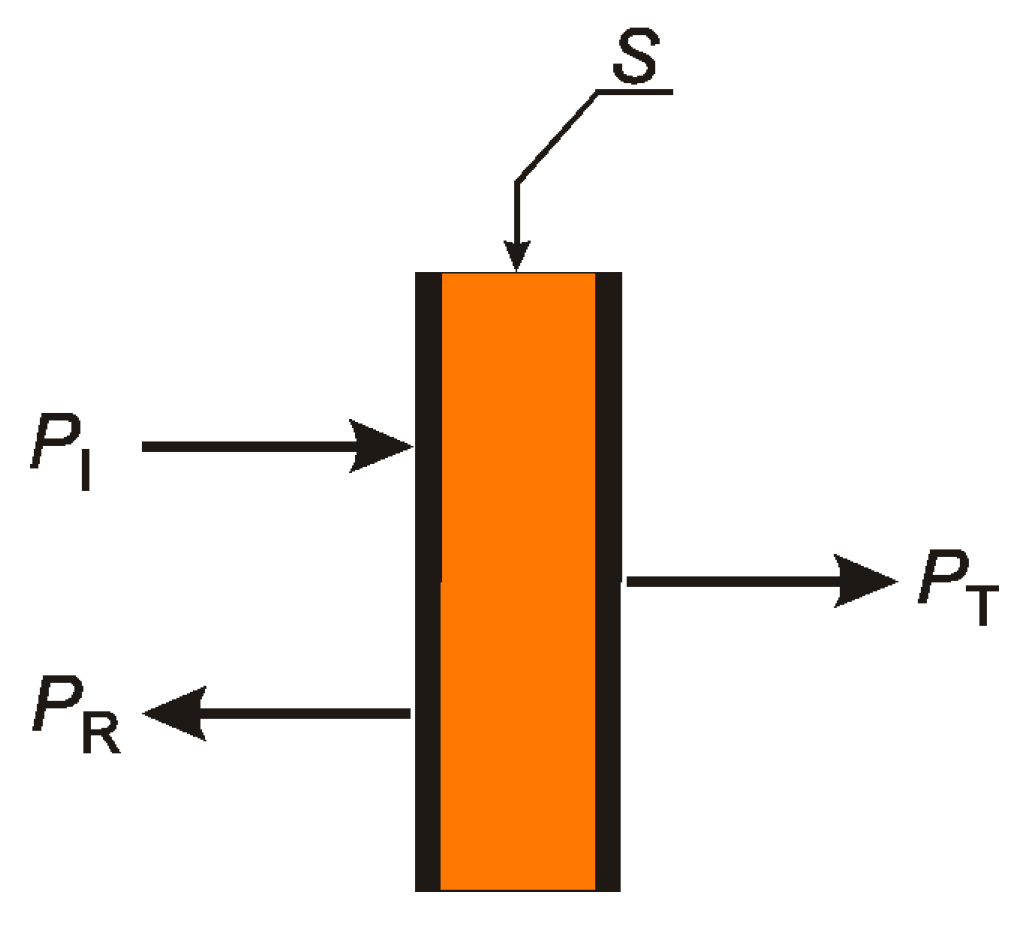


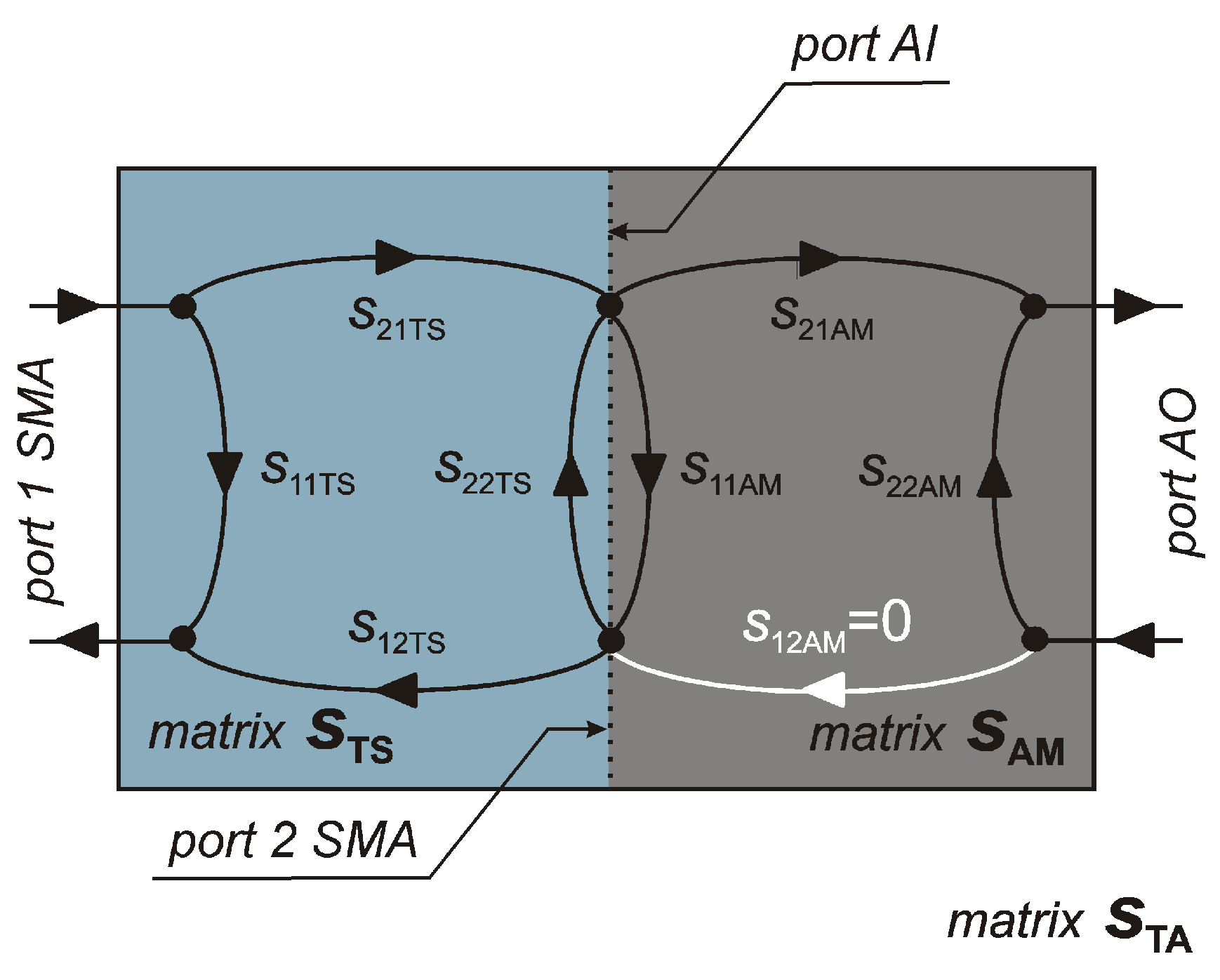
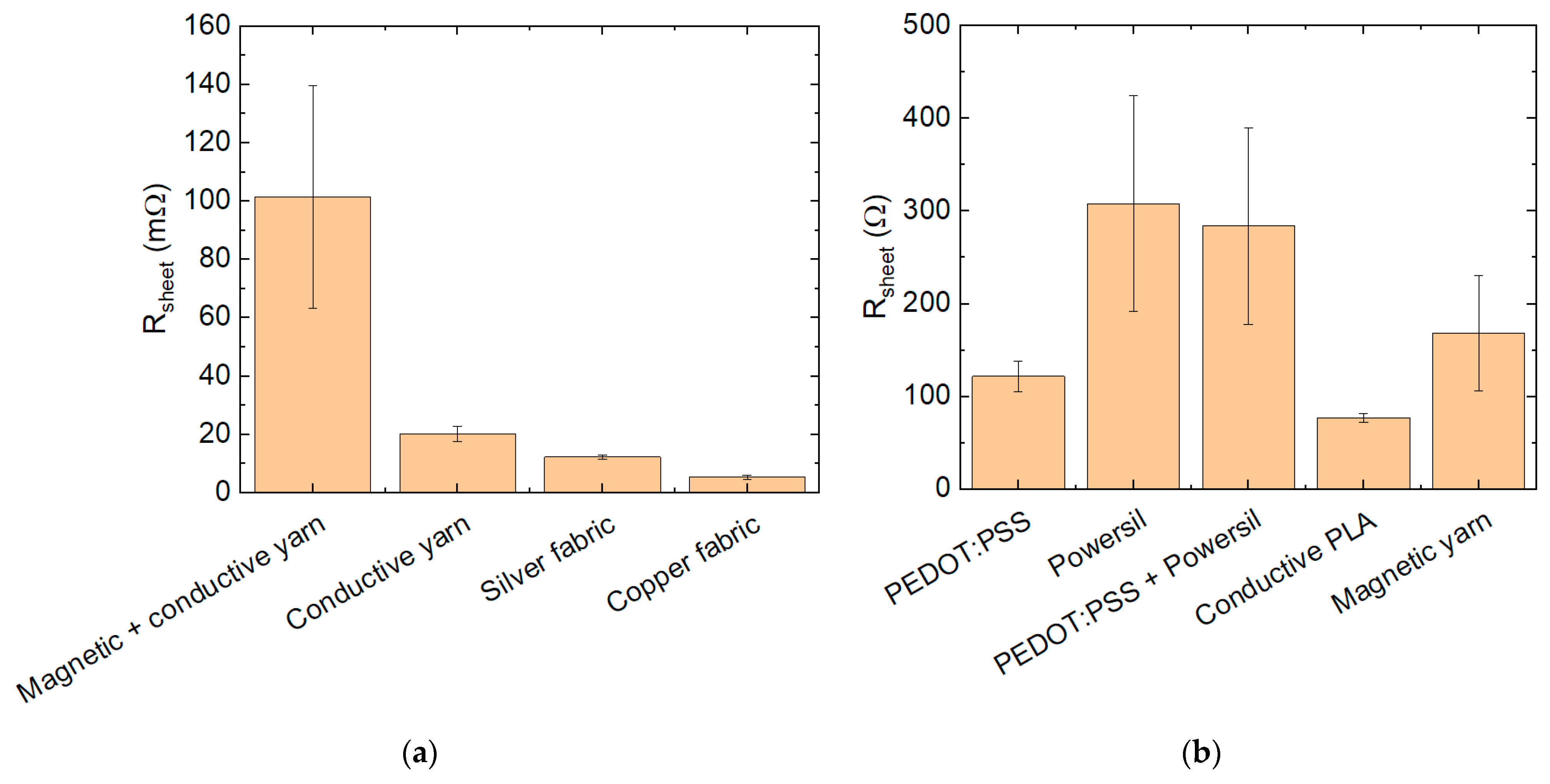
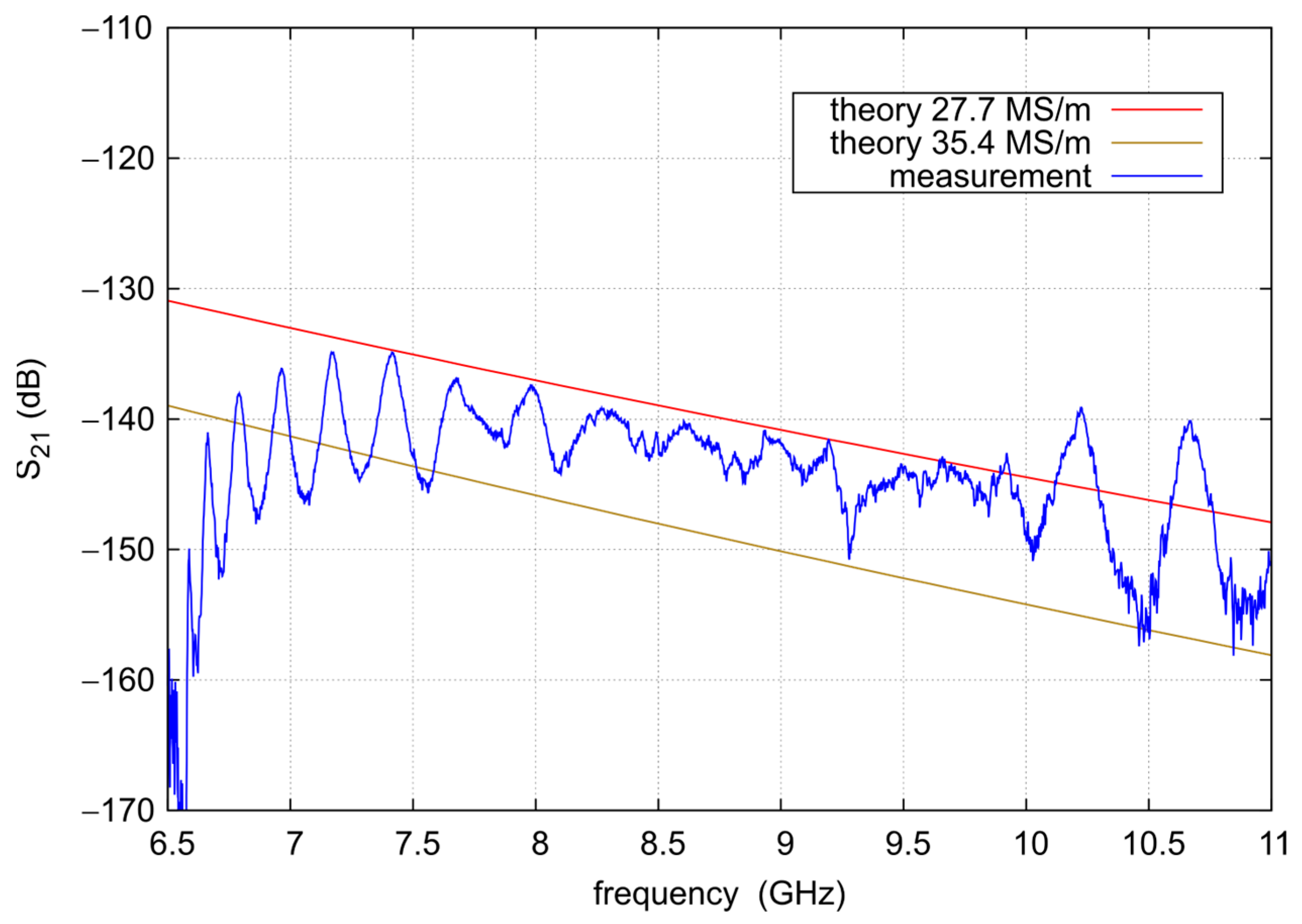
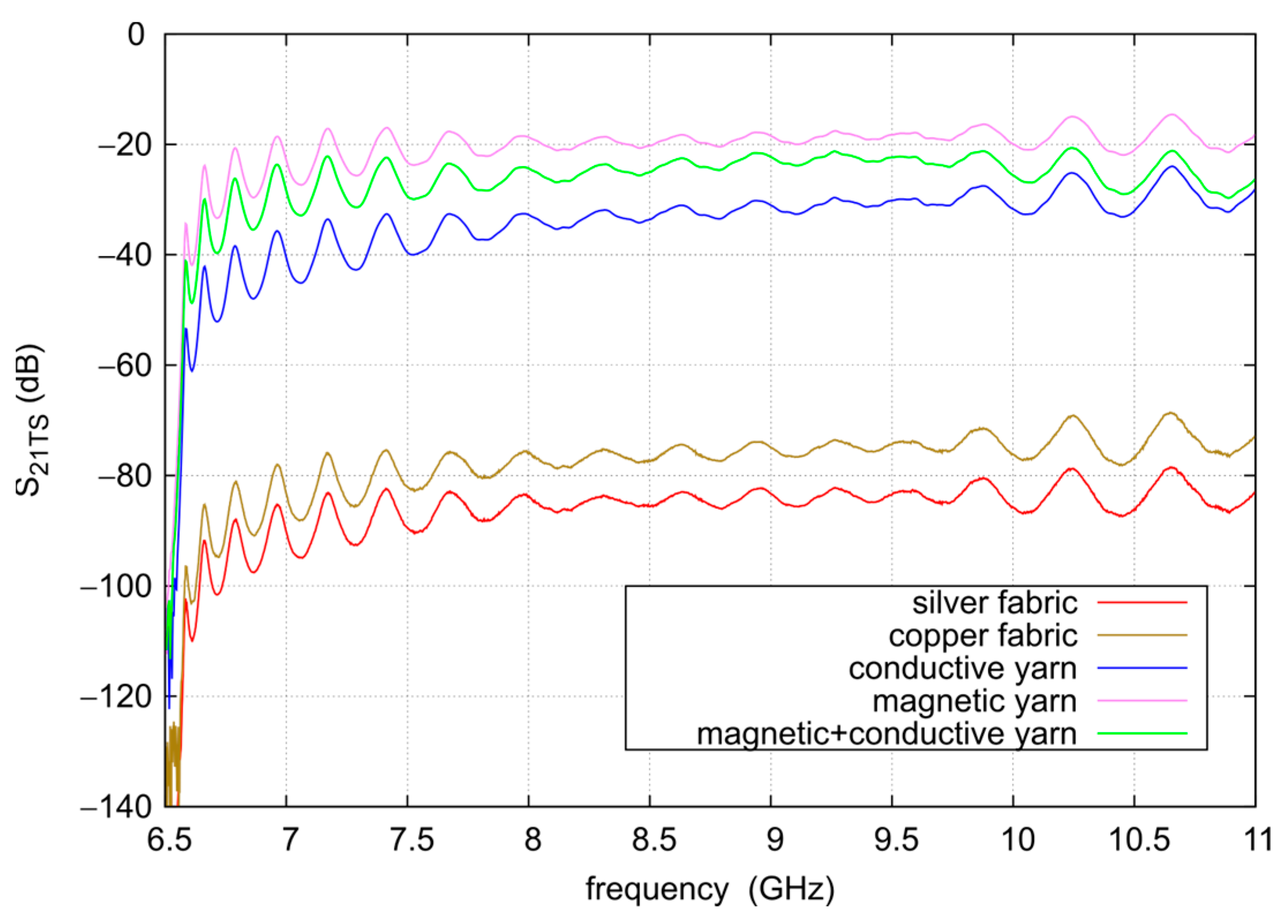

| Name | Description | Micrograph |
|---|---|---|
| PEDOT:PSS | Cotton woven fabric with PEDOT:PSS coating (40 warp threads/cm, 40 weft threads/cm) | 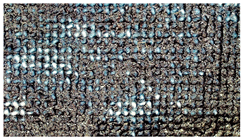 |
| Powersil | Cotton woven fabric with Powersil coating (40 warp threads/cm, 40 weft threads/cm) | 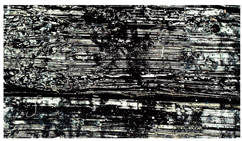 |
| PEDOT:PSS/Powersil | Cotton woven fabric with PEDOT:PSS and subsequent Powersil coating (40 warp threads/cm, 40 weft threads/cm) |  |
| Conductive yarn | Hand-crocheted fabric from 2 Shieldex yarns (2.6 wales/cm, 2.2 courses/cm) | 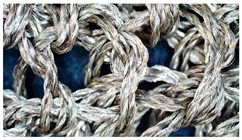 |
| Magnetic yarn | Hand-crocheted fabric from 2 S-Shield yarns (2.6 wales/cm, 2.2 courses/cm) |  |
| Magnetic + conductive yarn | Hand-crocheted fabric from 1 Shieldex + 1 S-Shield yarn (3.0 wales/cm, 1.8 courses/cm) | 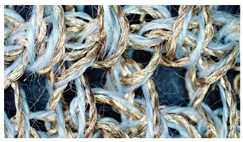 |
| Silver fabric | Silver-metalized woven fabric (74 warp threads/cm, 89 weft threads/cm) | 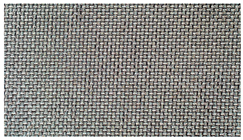 |
| Copper fabric | Copper-metalized woven fabric (65 warp threads/cm, 78 weft threads/cm) | 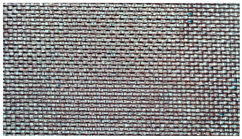 |
| PAN:nickel-ferrite 1:1 | Electrospun PAN nanofiber mat with nickel ferrite, mass ratio 1:1 | 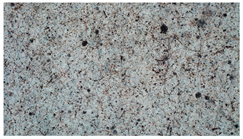 |
| PAN:nickel-ferrite 1:1.8 | Electrospun PAN nanofiber mat with nickel ferrite, mass ratio 1:1.8 | 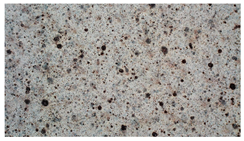 |
| PLA | 3 layers, FDM-printed |  |
| Conductive PLA | 3 layers, FDM-printed | 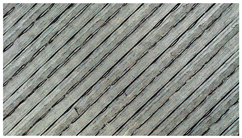 |
| Magnetic PLA | 3 layers, FDM-printed | 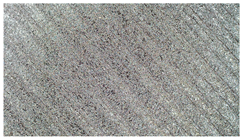 |
Disclaimer/Publisher’s Note: The statements, opinions and data contained in all publications are solely those of the individual author(s) and contributor(s) and not of MDPI and/or the editor(s). MDPI and/or the editor(s) disclaim responsibility for any injury to people or property resulting from any ideas, methods, instructions or products referred to in the content. |
© 2023 by the authors. Licensee MDPI, Basel, Switzerland. This article is an open access article distributed under the terms and conditions of the Creative Commons Attribution (CC BY) license (https://creativecommons.org/licenses/by/4.0/).
Share and Cite
Wójcik, D.; Surma, M.; Magnuski, M.; Blachowicz, T.; Tuvshinbayar, K.; Dotter, M.; Topuz, Y.; Ehrmann, A. Experimental Verification of the Shielding Properties of Selected Textile Materials in the X Frequency Band. Appl. Sci. 2023, 13, 9777. https://doi.org/10.3390/app13179777
Wójcik D, Surma M, Magnuski M, Blachowicz T, Tuvshinbayar K, Dotter M, Topuz Y, Ehrmann A. Experimental Verification of the Shielding Properties of Selected Textile Materials in the X Frequency Band. Applied Sciences. 2023; 13(17):9777. https://doi.org/10.3390/app13179777
Chicago/Turabian StyleWójcik, Dariusz, Maciej Surma, Mirosław Magnuski, Tomasz Blachowicz, Khorolsuren Tuvshinbayar, Marius Dotter, Yusuf Topuz, and Andrea Ehrmann. 2023. "Experimental Verification of the Shielding Properties of Selected Textile Materials in the X Frequency Band" Applied Sciences 13, no. 17: 9777. https://doi.org/10.3390/app13179777
APA StyleWójcik, D., Surma, M., Magnuski, M., Blachowicz, T., Tuvshinbayar, K., Dotter, M., Topuz, Y., & Ehrmann, A. (2023). Experimental Verification of the Shielding Properties of Selected Textile Materials in the X Frequency Band. Applied Sciences, 13(17), 9777. https://doi.org/10.3390/app13179777








